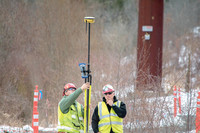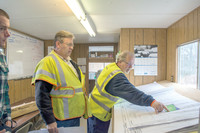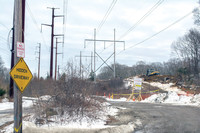By JOHN HOWELL -- Wearing a yellow-green florescent safety vest and a hard hat, Gary Boyle demanded site visitors stop...
This item is available in full to subscribers.
We have recently launched a new and improved website. To continue reading, you will need to either log into your subscriber account, or purchase a new subscription.
If you are a current print subscriber, you can set up a free website account by clicking here.
Otherwise, click here to view your options for subscribing.
Please log in to continue |
|



Wearing a yellow-green florescent safety vest and a hard hat, Gary Boyle demanded site visitors stop. While the lot under the high-tension wires and next to a construction trailer office offered plenty of room for parking, Boyle insisted each arrival wait for him to direct them into a designated location.
Boyle is the site safety officer for Manafort Construction, the company National Grid has selected to build a substation off New London Avenue not far from the Green Brier Condominiums and Valley Country Club. When completed, the $10 million to $12 million substation will be the sixth in a series of substations serving the central Rhode Island area, with the highest concentration of customers in Warwick and West Warwick.
“That’s really where the load growth is,” says Daniel McIntyre, principal civil engineer for National Grid, of the two municipalities. As it operates now, the four substations step down voltage from the four-line high power artery serving central and northern Rhode Island are operating at peak capacity during periods of high demand.
The new substation, explains McIntyre, will allow for residential and commercial growth for the area. But there’s more to it than the potential for growth.
“It’s safer,” said McIntyre as the visiting entourage gathered in the construction trailer.
“Safety” is a word that Boyle is all about.
Backing vehicles into assigned areas isn’t a fixation with orderliness. It’s about being away from the high-tension wires overhead and an orderly evacuation plan. Boyle insisted on a safety briefing before the tour. He opened with a weather report. It was 31 degrees and he described site conditions where the roads of packed scrabble rock were slick with snow melt and ice. Pointing to an air horn he said 10 shot blasts signal an emergency.
Inch-thick cables that are clipped to iron stakes driven down to bedrock, ground earth moving equipment working within the transmission area.
It’s all a precaution should the arm of an excavator touch one of the wires or come close enough for the electricity to ark to the vehicle and possibly electrocute the operator. Boyle even described the route to nearby Kent Hospital to the group.
There’s good reason for safety measures. Shortly, crews will commence blasting the ledge rock that makes up much of the 200 by 130-foot pad for the substation for the 40 by 12-foot building that will house the transformer. The pad is large enough to accommodate a second transformer if needed.
Boyle estimated there are “40 day’s worth” of blasting. After each blast that follows a strict protocol that includes clearing the area, signals and heavy iron mats over the blast site, the fractured rock is excavated and transported to a crusher on site. The rock will then be used to build a foundation to a depth of eight feet.
“It’s not like television,” Boyle said of the blasts, “with stuff flying everywhere.” He described the blasts as a non-event, a “poof” where the ground shakes.
Still, that is of concern to National Grid.
Abeni Keldria, stakeholder specialist for National Grid, who was also along for the tour, said that 100 residents, all abutters within 300 feet of the project, have had pre-blast surveys of their properties that involved documenting property conditions with photographs. Neighbors receive periodic updates on the project and there have been three meetings – open houses – since the project was announced.
McIntyre said the substation should be up and operational by the end of this year. It won’t be manned. Crews will visit it on a schedule. The site has been designed to accommodate runoff water, landscaped to hide it from the abutting condo complex and have a wall to shield neighbors from the noise of the transformer.
With all the details spelled out, a tour of the site appeared to be the next step.
Not so fast.
Doyle said the wet and icy conditions required heavy boots or ice spikes that could be pulled over shoes.
The group went as far as the site entrance. There wasn’t much to see other than wires and the profile of a shovel moving earth on the hill ahead. No one was going any further.
Doyle looked apologetic.
“We hold to high safety standards,” he said.
Comments
No comments on this item Please log in to comment by clicking here